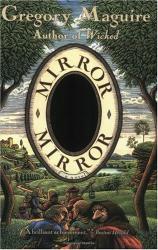Reading Group Guide
Discussion Questions
Mirror Mirror

1. Maguire has said he doesn't want to be known as the writer who retells children's stories for adults. Is Mirror Mirror a retelling of the story of Snow White, or is it something else? Something more than a fairy tale? Something less?
2. The version of Snow White that we are most familiar with is from the collection of the Brothers Grimm. Countless picture books as well as film and theater adaptations set the book where the story itself was collected: in the shadowy woods of Bavaria, Germany. There is a northern cast to the telling even in the title: Snow is less familiar in the Mediterranean than in the Black Forrest. What undertones arise when telling the story in a northern clime that are absent in a Mediterranean setting? How does the story change by being set on sunny Tuscan slopes rather than in the aromatic pines forests of the Alps?
3. An airy tale exists in a kind of "nevertime." The famous "Once upon a time" beginning of the old tales generally signals a setting vaguely medieval, freed from cultural or historic details that would pin the story down to a specific century. To paraphrase writer and critic Jane Langton, a fairy tale happens in an amorphous period some time between the fall of Constantinople and the invention of the internal combustion engine. We expect wishing wells, swords, goblets, maybe even battering rams and spinning wheels; we don't expect spectacles, wheelchairs, a postal service. What does it do to an old tale to slap it into a particular set of decades -- in the instance of Mirror Mirror, the first three decades of the sixteenth century? Is that story at home here?
4. Mirror Mirror, more than any other novel of Maguire's, features figures from history. Lucrezia Borgia and her bother Cesare Borgia, the model for Machiavelli's The Prince, have central roles. (Think how the traditional prince who wakes Snow White with a kiss differs from Machiavelli's The Prince!) Pope Alexander VI, his courtesan la Cattanei, the scientist Paraclesus, the poet and typeface designer Pietro Bembo are referred to in passing. (Maguire has mentioned that a temptation he found very difficult to resist was to find roles for the young Michelangelo, the older da Vinci -- so many famous figures of the High Renaissance were thriving in these decades.) Is the inclusion of actual figures in a tale of fancy in any way dismissive of their place in history? Does it strengthen the story?
5. In Disney's Snow White, the dwarves are named. This was a daring move, for in a fairy tale, creatures like dwarves, woodland animals, crones in the wood, and so on, are meant to perform a universal function, to stand in, like a Greek chorus, for the rest of the world. To name the dwarves is to confer individuality upon them and to threaten to muddy the focus of the story. How does Maguire play with this stress in his naming the dwarves in Mirror Mirror?
6. Maguire was planning to begin the first draft of Mirror Mirror just after his kids began the school year in September 2001. He was still making notes on September 11, 2001. Writing seemed futile and self-absorbed in those nightmarish weeks. Can you see why the first lines Maguire could bring himself to write of Mirror Mirror were the four lines on page 32
I am a girl who did no wrong.
I walked this side of Gesù when I could.
I kept an angel in my apron poacket.
I do not think it did me any good.
7. In a sense, the original story of Snow White is a story of maturation, of evolution. How do each of the characters evolve in Mirror Mirror?
8. In terms of symbolic weight, the apple in the Snow White tale -- the poisoned apple -- is likened to the apples from the Tree of Knowledge in the Garden of Eden. How farfetched is this association? Does it work?
9. In her monologue in the chapter called "Mirror Mirror" (page 187), Lucrezia Borgia muses: "Out of out need we patronize our artists, we flirt with our poets, we petition our architects: Give us your lusty colorful world. Signal to us a state of being more richly steeped in purpose and satisfaction than our own" Of course her life of wealth, power, and comfort proves relatively unsatisfactory. She is always hungry for more. Perhaps it is the storyteller and the novelist who provide their "lusty colorful world" to nurture us, distract us, console us. The philosopher Roger Scruton said, "The consolation of imaginary things is not imaginary consolation." Is this true of Mirror Mirror? If there is consolation to be had in his novel, what is its character?
10. For an alternate version of a Snow White tale by Gregory Maguire, take a look at the short story called "The Seven Stage Comeback" in A Wolf at the Door and Other Retold Fairy Tales, edited by Ellen Datlow and Terri Windling, published by Simon and Schuster. For another alternate version check out "So What and the Seven giraffes," included in Maguires collection called Leaping Beauty and Other Animal Fairy Tales, published by HarperCollins children's division. What is it about fairy tales that they can survive multiples retellings, even by the same author? Perhaps not only survive retellings, but thrive on them?
11. Who is the fairest one of all?
Mirror Mirror
- Publication Date: September 28, 2004
- Genres: Fiction
- Paperback: 320 pages
- Publisher: Harper Paperbacks
- ISBN-10: 0060988657
- ISBN-13: 9780060987527








